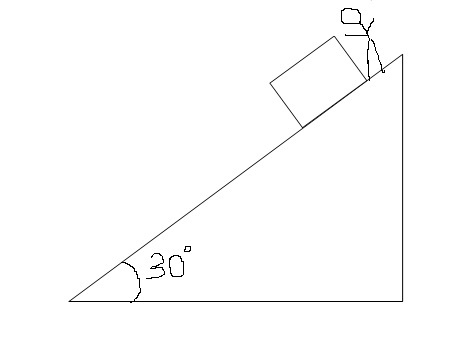Questions

Q1) A man wants to slide down a block of mass which is kept on a fixed inclined plane of inclination as shown . Initially, the block is not sliding. to just start sliding, the man pushes the block down the incline with a force . Now the block starts accelerating. To move it downwards with constant speed, the man starts pulling the block with the same force. Surfaces are such that ratio of maximum static friction to kinetic friction is .
a)what is the value of
b) If the man wants to move the block up the incline, what is minimum force required to just start the motion
c) What is the minimum force required to move it up the incline with constant speed
d) If the man continues pushing the block by force by force , the acceleration would be
Easy Math Editor
This discussion board is a place to discuss our Daily Challenges and the math and science related to those challenges. Explanations are more than just a solution — they should explain the steps and thinking strategies that you used to obtain the solution. Comments should further the discussion of math and science.
When posting on Brilliant:
*italics*or_italics_**bold**or__bold__paragraph 1
paragraph 2
[example link](https://brilliant.org)> This is a quote# I indented these lines # 4 spaces, and now they show # up as a code block. print "hello world"\(...\)or\[...\]to ensure proper formatting.2 \times 32^{34}a_{i-1}\frac{2}{3}\sqrt{2}\sum_{i=1}^3\sin \theta\boxed{123}Comments
Log in to reply
thanks @Kushal Patankar @Nishant Rai for the help
Log in to reply
Always ready to help you , friend.
Log in to reply
Can you guys help me here?
@Kushal Patankar @Nishant Rai @Tanishq Varshney
Tanishq I need your help here
Let coefficient of friction be ηs,ηk then ηkNηsN=2→ ηkηs=2
for the block to just move downward, forces should balance each other along the incline.
i am just writing the equations, check if these are correct.
F+mgsinθ=ηsmgcosθ......(i) in case of just sliding downwards.
F=mgsinθ−ηkmgcosθ.....(ii) in case of pulling it upwards.
equating the first two equations, we get ηk=332
On substituting the value of ηk in eq (ii), we get 6mg
Log in to reply
b) F−mgsinθ−ηsmgcosθ=0
c) F−mgsinθ−ηkmgcosθ=0
d) ma=F+mgsinθ−ηkmgcosθ→a=6g
@Nishant Rai @Saurabh Patil @satvik pandey @Kushal Patankar plz help by posting solution
Log in to reply
Looks I am late. :) There was some problem with internet connection that's why I was unable to help you.
Log in to reply
no problem, the above problem was sorted out
Log in to reply
How is preparations going on, for ADVANCE?
@Azhaghu Roopesh M @Raghav Vaidyanathan @Rohit Shah @Ronak Agarwal @Mvs Saketh
What is answer to F
Log in to reply
6mg
Log in to reply
answers to b,c,d ?
Log in to reply
b) 7mg/6
c) 5mg/6
d) g/3
Tanishq Varshney Kushal Patankar Can You please provide the exact solutions for these problems ? Please Help.
example link 1
example link 2
example link 3
i have a doubt. On solving the equations, we get ηs=334 which is greater than tanθ , which means the body will not move on its own down the inclined plane. Then how in the second case, the body starts accelerating downwards , and a pulling force is required to move the block with a constant speed? i mean the body cannot move on its own if tanθ<η .
Log in to reply
Do you think static friction will act at its maximum value.
@Tanishq Varshney @Kushal Patankar